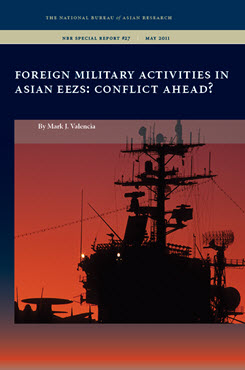NBR Special Report no. 27
Foreign Military Activities in Asian EEZS
Conflict Ahead?
This essay describes the maritime geostrategic context and changing security paradigm in Asia, delineating where, how, and why the maritime perceptions, strategies, and policies of key Asian actors clash with those of their neighbors and the U.S.
EXECUTIVE SUMMARY
MAIN ARGUMENT
The political and legal defense of U.S. military activities in foreign exclusive economic zones (EEZ), such as China’s, is not guaranteed to succeed. Law and practice in this regard are evolving. Unless some understanding and accommodation are reached regarding various “red lines,” serious international incidents are likely to increase in frequency and intensity. Possible ways forward, which are not mutually exclusive, include managing the evolution of the status quo, U.S.-China bilateral agreements, international arbitration, and a regional agreement, perhaps led by ASEAN.
POLICY IMPLICATIONS
- A more effective approach to U.S. military operations in foreign EEZs that would enhance U.S. soft power would be to discuss, negotiate, and, if feasible, accommodate other countries’ main security concerns.
- Ratification of the 1982 UN Convention on the Law of the Sea (UNCLOS) would greatly strengthen the U.S. political and legal position in these matters.
- The U.S. should consider taking the lead in negotiating a set of voluntary guidelines regarding foreign military activities in EEZs that would be conducive to a stable and secure maritime environment in Asia.
- If the U.S. continues its military activities in foreign EEZs, eschews agreements or voluntary guidelines, and does not ratify the UNCLOS, a regime may evolve without U.S. input, which would not be in U.S. interests.


